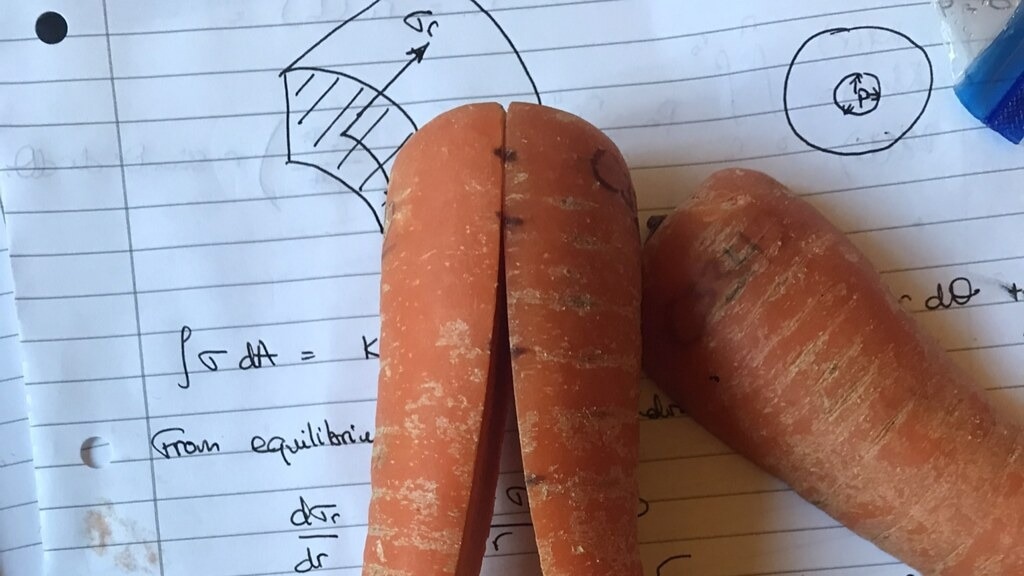University of Bath researchers have measured the mechanisms that cause popular root vegetables to curl up if they are left uneaten for an extended period of time and have unearthed the secret science of preparing them.
 The carrot curling research was carried out within Nguyen Vo-Bui's kitchen during the lockdown. Image Credit: University of Bath
The carrot curling research was carried out within Nguyen Vo-Bui's kitchen during the lockdown. Image Credit: University of Bath
Nguyen Vo-Bui, a final-year Mechanical Engineering student, conducted research under the restricted conditions of the 2021 COVID-19 lockdowns.
Nguyen set out to determine the geometrical and environmental parameters that most affect the longevity of carrots without the use of a laboratory.
He employed finite-element (FE) models, often used in structural engineering, to characterize, analytically simulate, and verify the aging of more than 100 lengthwise-cut Lancashire Nantes carrot halves as he worked in his kitchen.
The research team came to the conclusion that the two main causes of the curling behavior were dehydration and residual stressors. The carrot's softcore vein, also called the vascular cylinder, is softer than its starchy outer layer, or cortex—the two carrot halves curl when cut lengthwise because of the imbalance in stress. Dehydration causes more rigidity to be lost, which intensifies the curling effect.
To preserve their inherent qualities and lengthen their edible life, they advise manufacturers to handle carrots in cold, wet, airtight, and humidity-controlled conditions.
They explain that the process probably applies to different plant structures and that the work offers a mechanism to forecast the deformation of chopped root vegetables. By using the new mathematical tool developed by the study to design packaging and food handling procedures, food companies may be able to minimize food waste.
Carrots are renowned for their excellent production efficiency and rank among the world's most valuable commodities by market value, although loss is still substantial. About 25–30% of this happens before it is processed and packaged as a result of defects, mechanical harm, or diseased areas.
Carrots that have been freshly chopped and hardly processed are a handy, ready-to-use product that allows the use of carrots that might otherwise be thrown away, therefore cutting down on food waste.
We have mathematically represented the curl of a cut carrot over time and showed the factors that contribute to curling. Our motivation was to look for ways to improve the sustainability of carrot processing and make them as long-lasting as possible. We have produced a methodology that a food producer could use to change their processes, reducing food waste and making packaging and transportation more efficient. Understanding the bending behavior in such systems can help us to design and manufacture products with higher durability.”
Dr. Elise Pegg, Study Co-Author and Senior Lecturer, Department of Mechanical Engineering, University of Bath
Elise further explained, “A question like this would normally be investigated from a biological perspective, but we have done this work using purely mechanical principles. I'm so pleased for Nguyen – it is a measure of his resourcefulness and dedication to produce such interesting research in a challenging situation.”
The average radius of each carrot's curvature decreased from 1.61 m to 1.1 m over the course of a week, indicating an increase in the curl of the carrot halves. Along with the carrots drying out, there was a 1.32 times decrease in stiffness; on average, their weight decreased by 22%.
This was interesting research – to apply mechanical principles to vegetables was surprising and fun. One of the big challenges was to devise an experiment that could be done in a lockdown setting without access to normal labs and equipment. To now be in a position to have this work published in an academic journal and potentially be used by the food industry is really rewarding.”
Nguyen Vo-Bui, Study Co-Author, Department of Mechanical Engineering, University of Bath
Nguyen said, “This project has inspired me to continue my studies at the University of Bath, and I am now studying residual stresses in porous ferroelectric ceramics for my PhD.”
Finding uses for the 30 kg of carrots that the experiment required after that posed an additional challenge, in addition to transporting them in a suitcase. Nguyen and his roommates were well-fed for several days thanks to carrot cake, carrot pesto, and the Indian carrot delicacy Gajar Ka Halwa, among many other delicacies.
Source:
Journal reference:
Nguyen A., et.al., (2024). Modelling of longitudinally cut carrot curling induced by the vascular cylinder-cortex interference pressure. The Royal Society. doi.org/10.1098/rsos.230420.